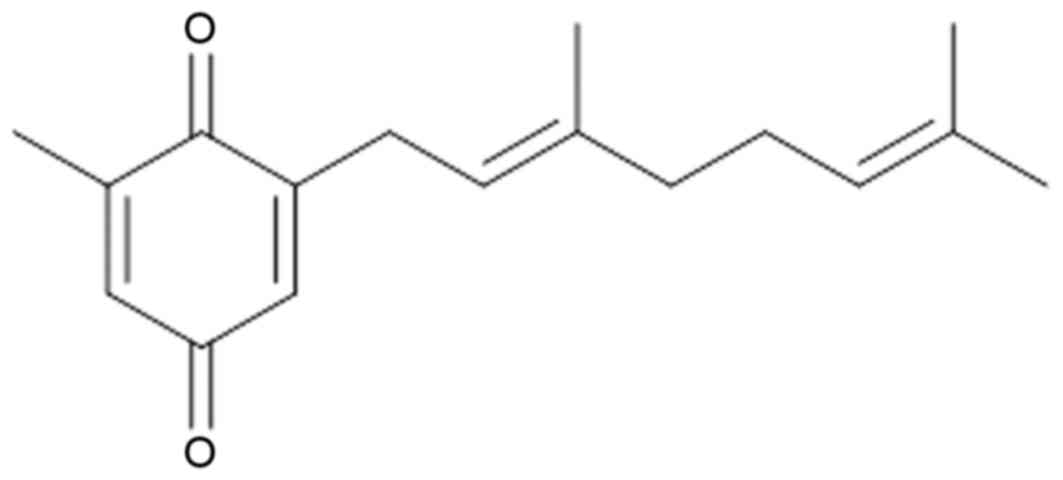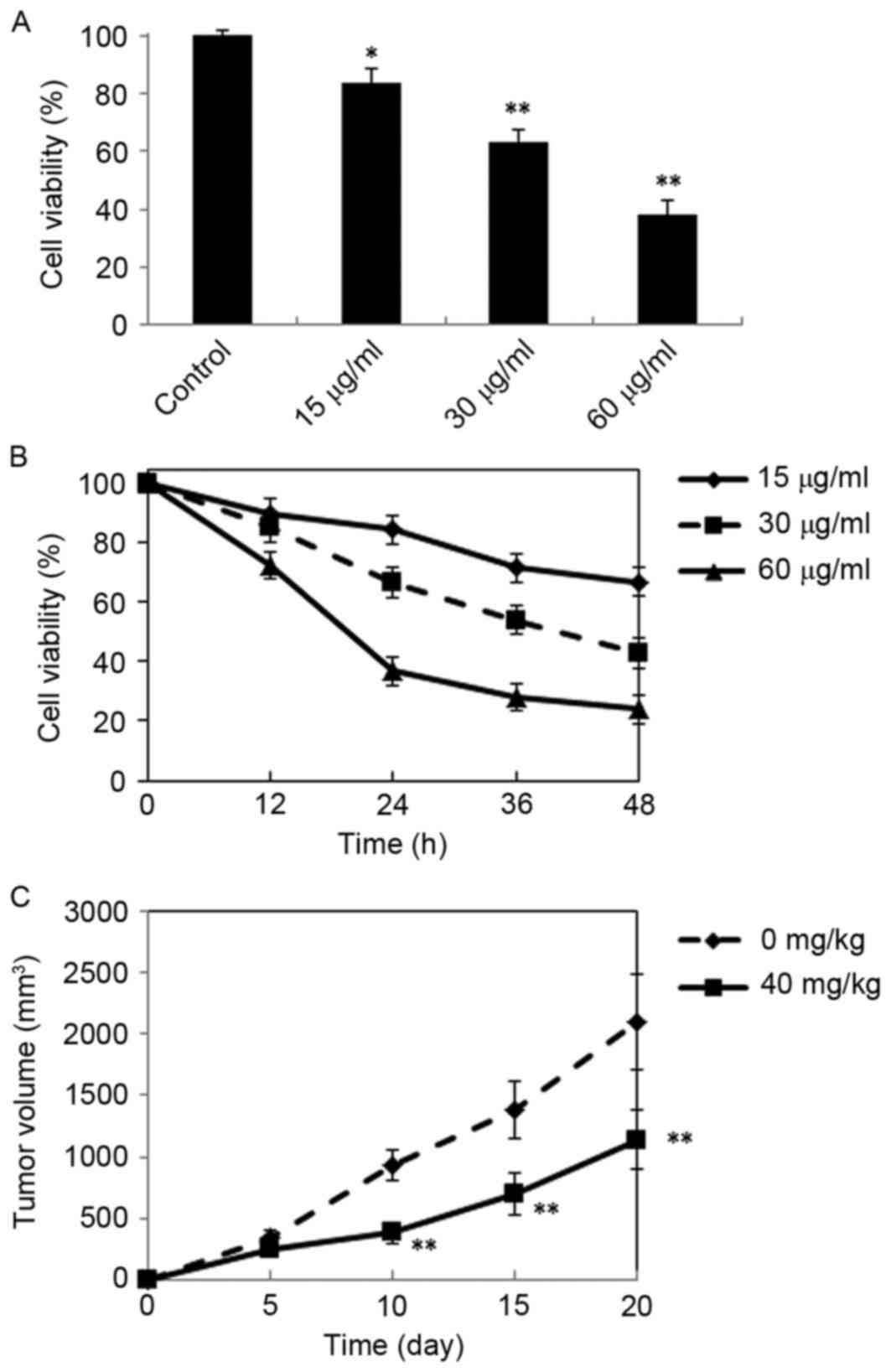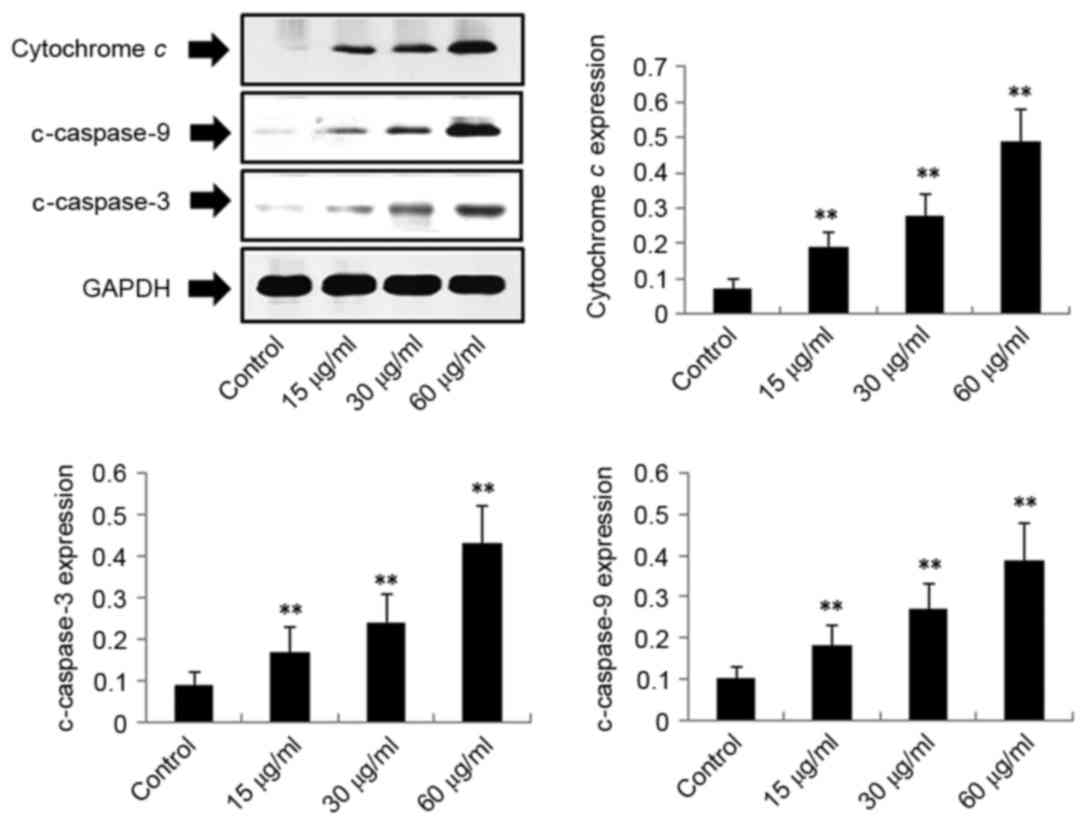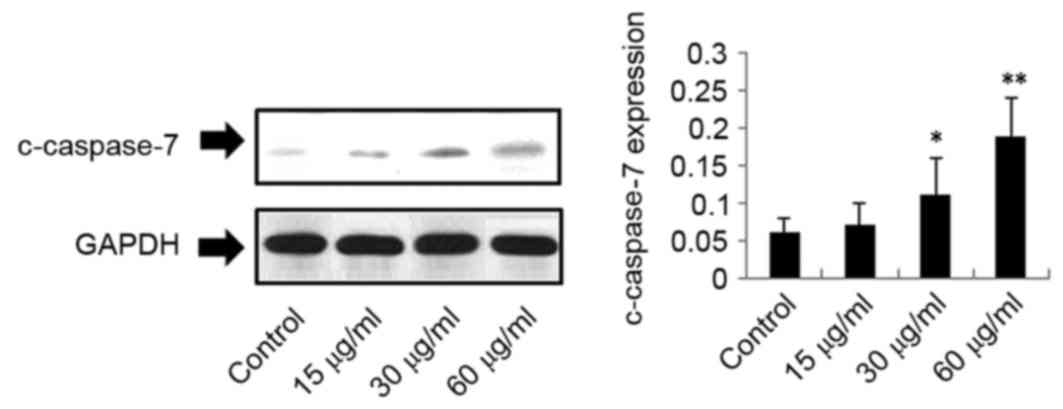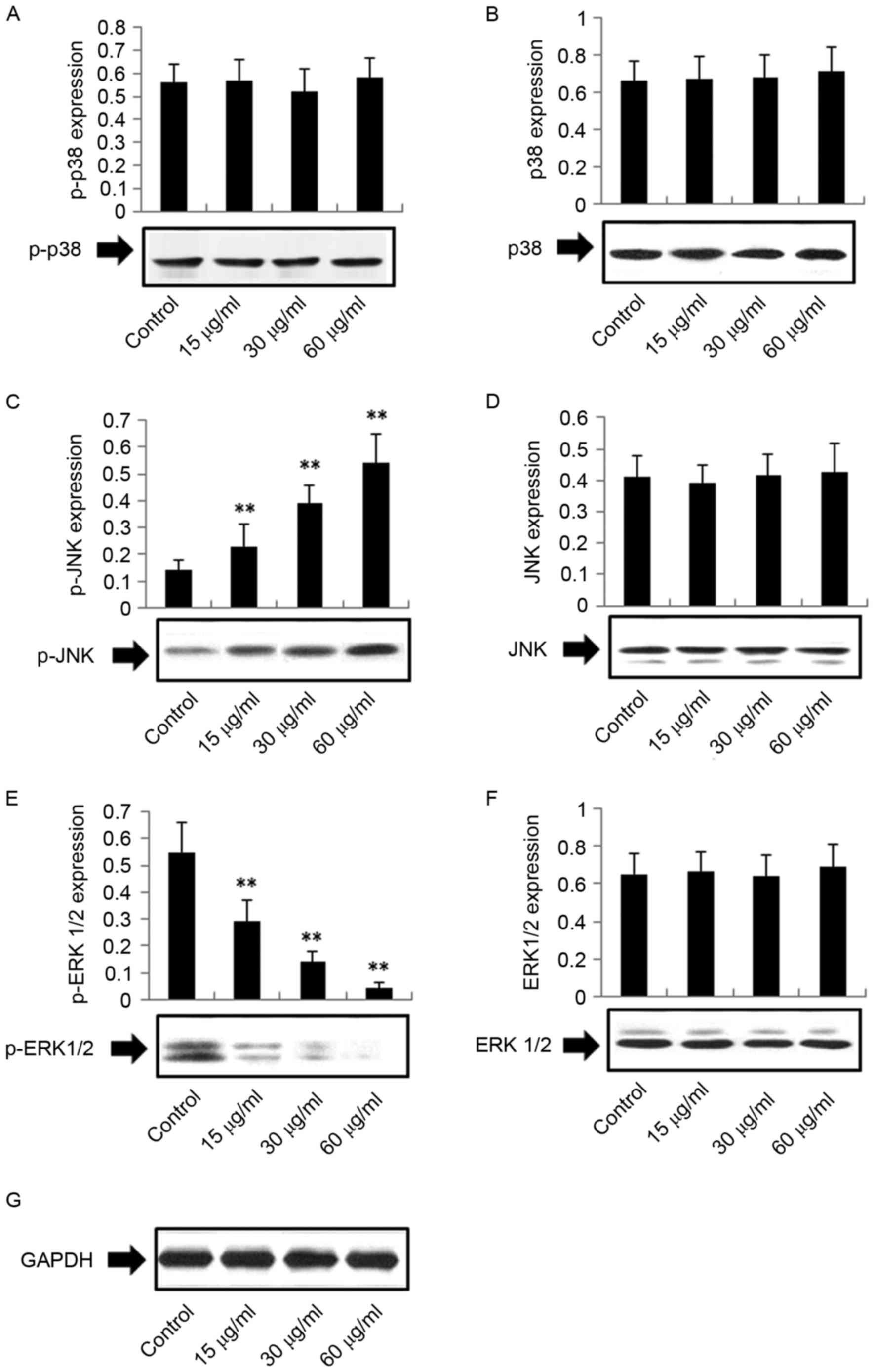|
1
|
Xie QC and Yang YP: Anti-proliferative of
physcion 8-O-β-glucopyranoside isolated from Rumex japonicas Houtt.
on A549 cell lines via inducing apoptosis and cell cycle arrest.
BMC Complem Altern Med. 14:3772014. View Article : Google Scholar
|
|
2
|
Li JP, Zhao DL, Jiang HJ, Huang YH, Li DQ,
Wan Y, Liu XD and Wang JE: Assessment of tumor vascularization with
functional computed tomography perfusion imaging in patients with
cirrhotic liver disease. Hbpd Int. 10:43–49. 2011.PubMed/NCBI
|
|
3
|
Bruix J and Llovet JM: Prognostic
assessment and evaluation of the benefits of treatment. J Clin
Gastroenterol. 35 5 Suppl 2:S138–S142. 2002. View Article : Google Scholar : PubMed/NCBI
|
|
4
|
Marra M, Sordelli IM, Lombardi A, Lamberti
M, Tarantino L, Giudice A, Stiuso P, Abbruzzese A, Sperlongano R,
Accardo M, et al: Molecular targets and oxidative stress biomarkers
in hepatocellular carcinoma: An overview. J Transl Med. 9:1712011.
View Article : Google Scholar : PubMed/NCBI
|
|
5
|
Katsuta E, Tanaka S, Mogushi K, Matsumura
S, Ban D, Ochiai T, Irie T, Kudo A, Nakamura N, Tanaka H, et al:
Age-related clinicopathologic and molecular features of patients
receiving curative hepatectomy for hepatocellular carcinoma. Am J
Surg. 208:450–456. 2014. View Article : Google Scholar : PubMed/NCBI
|
|
6
|
Kasai K, Kuroda H and Suzuki K: Adjuvant
therapy after treatment of hepatocellular carcinoma. Nippon
Shokakibyo Gakkai Zasshi. 105:787–794. 2008.(In Japanese).
PubMed/NCBI
|
|
7
|
Caraglia M, Giuberti G, Marra M, Addeo R,
Montella L, Murolo M, Sperlongano P, Vincenzi B, Naviglio S, Prete
SD, et al: Oxidative stress and ERK1/2 phosphorylation as
predictors of outcome in hepatocellular carcinoma patients treated
with sorafenib plus octreotide LAR. Cell Death Dis. 2:e1502011.
View Article : Google Scholar : PubMed/NCBI
|
|
8
|
Fokunang CN, Ndikum V, Tabi OY, Jiofack
RB, Ngameni B, Guedje NM, Tembe-Fokunang EA, Tomkins P, Barkwan S,
Kechia F, et al: Traditional medicine: Past, present and future
research and development prospects and integration in the national
health system of Cameroon. Afr J Tradit Complement Altern Med.
8:284–295. 2011.PubMed/NCBI
|
|
9
|
Xie Q, Yang Y, Wang Z, Chen F, Zhang A and
Liu C: Resveratrol-4-O-D-(2′-galloyl)-glucopyranoside isolated from
Polygonum cuspidatum exhibits anti-hepatocellular carcinoma
viability by inducing apoptosis via the JNK and ERK pathway.
Molecules. 19:1592–1602. 2014. View Article : Google Scholar : PubMed/NCBI
|
|
10
|
Zhong YM and Feng YF: Advance on the
chemical constituents and pharmacological effects of Atractylodes
macrocephala Koidz. J Guangdong Coll Pharm. 1–221. 2012.
|
|
11
|
Peng W, Han T, Liu Q and Qin L: Chemical
constituents from aerial part of Atractylodes macrocephala.
Zhongguo Zhong Yao Za Zhi. 36:578–581. 2011.(In Chinese).
PubMed/NCBI
|
|
12
|
National Institute of Health (NIH), .
Public health service policy on humane care and use of laboratory
animals. NIH; Bethesda, MD, USA: 2002
|
|
13
|
Resch M, Steigel A, Chen ZL and Bauer R:
5-Lipoxygenase and cyclooxygenase-1 inhibitory active compounds
from Atractylodes lancea. J Nat Prod. 61:347–350. 1998. View Article : Google Scholar : PubMed/NCBI
|
|
14
|
Yang XK, Xu MY, Xu GS, Zhang YL and Xu ZX:
In vitro and in vivo antitumor activity of scutebarbatine A on
human lung carcinoma A549 cell lines. Molecules. 19:8740–8751.
2014. View Article : Google Scholar : PubMed/NCBI
|
|
15
|
Mattern J and Volm M: Imbalance of cell
proliferation and apoptosis during progression of lung carcinomas.
Anticancer Res. 24:4243–4246. 2004.PubMed/NCBI
|
|
16
|
Liu YL, Tang LH, Liang ZQ, You BG and Yang
SL: Growth inhibitory and apoptosis inducing by effects of total
flavonoids from Lysimachia clethroides Du by in human chronic
myeloid leukemia K562 cells. J Ethnopharmacol. 131:1–9. 2010.
View Article : Google Scholar : PubMed/NCBI
|
|
17
|
Okada H and Mak TW: Pathways of apoptotic
and non-apoptotic death in tumor cells. Nat Rev Cancer. 4:592–603.
2004. View
Article : Google Scholar : PubMed/NCBI
|
|
18
|
Chipuk JE, McStay GP, Bharti A, Kuwana T,
Clarke CJ, Siskind LJ, Obeid LM and Green DR: Sphingolipid
metabolism cooperates with Bak and Bax to promote the mitochondrial
pathway of apoptosis. Cell. 148:988–1000. 2012. View Article : Google Scholar : PubMed/NCBI
|
|
19
|
Delivani P and Martin SJ: Mitochondrial
membrane remodeling in apoptosis: An inside story. Cell Death
Differ. 13:2007–2010. 2006. View Article : Google Scholar : PubMed/NCBI
|
|
20
|
Guerra-Castellano A, Díaz-Moreno I,
Velázquez-Campoy A, De la Rosa MA and Díaz-Quintana A: Structural
and functional characterization of phosphomimetic mutants of
cytochrome c at threonine 28 and serine 47. Biochim Biophys Acta.
1857:387–395. 2016. View Article : Google Scholar : PubMed/NCBI
|
|
21
|
Zheng TS and Li X: Research progress in
mitochondrial apoptosis pathway. Yixue Zongshu. 19:3282–3285.
2013.(In Chinese).
|
|
22
|
McIlwain DR, Berger T and Mak TW: Caspase
functions in cell death and disease. Cold Spring Harb Perspect
Biol. 5:a0086562013. View Article : Google Scholar : PubMed/NCBI
|
|
23
|
Xu J, Jiang S, Li Y, Li M, Cheng Q, Zhao
D, Yang B, Jia Z, Wang L and Song L: Caspase-3 serves as an
intracellular immune receptor specific for lipopolysaccharide in
oyster Crassostrea gigas. Dev Comp Immunol. 61:1–12. 2016.
View Article : Google Scholar : PubMed/NCBI
|
|
24
|
Gao N, Budhraja A, Cheng S, Yao H, Zhang Z
and Shi X: Induction of apoptosis in human leukemia cells by grape
seed extract occurs via activation of c-Jun NH2-terminal kinase.
Clin Cancer Res. 15:140–149. 2009. View Article : Google Scholar : PubMed/NCBI
|
|
25
|
Chang L and Karin M: Mammalian MAP kinase
signalling cascades. Nature. 410:37–40. 2001. View Article : Google Scholar : PubMed/NCBI
|
|
26
|
Pearson G, Robinson F, Gibson T Beers, Xu
BE, Karandikar M, Berman K and Cobb MH: Mitogen-activated protein
(MAP) kinase pathways: Regulation and physiological functions.
Endocr Rev. 22:153–183. 2001. View Article : Google Scholar : PubMed/NCBI
|
|
27
|
Boutros T, Chevet E and Metrakos P:
Mitogen-activated protein (MAP) Kinase/MAP kinase phosphatase
regulation: Roles in cell growth, death, and cancer. Pharmacol Rev.
60:261–310. 2008. View Article : Google Scholar : PubMed/NCBI
|
|
28
|
Gao N, Budhraja A, Cheng S, Liu EH, Huang
C, Chen J, Yang Z, Chen D, Zhang Z and Shi X: Interruption of the
MEK/ERK signaling cascade promotes dihydroartemisinin-induced
apoptosis in vitro and in vivo. Apoptosis. 16:511–523. 2011.
View Article : Google Scholar : PubMed/NCBI
|



